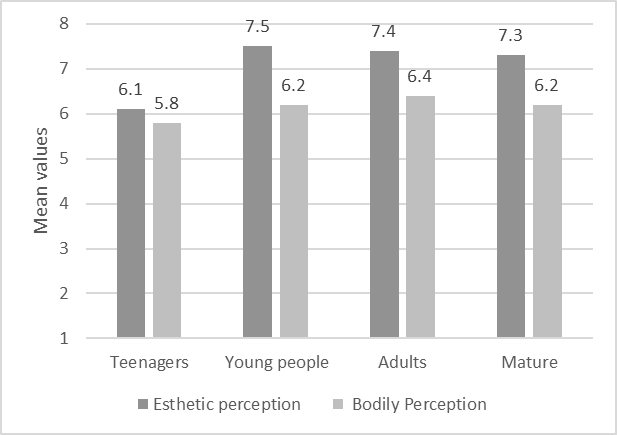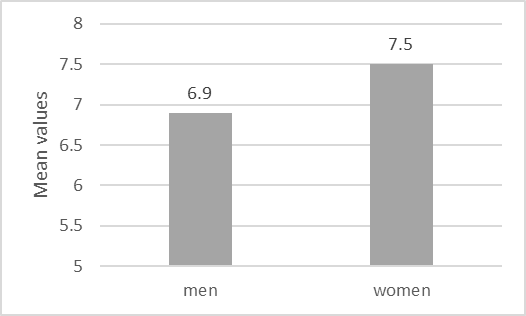Abstract
The article is dedicated to the research of an affective component of ecological consciousness – feeling of unity with nature. On the first stage a questionnaire was developed, which allowed us to identify two components of the feeling of unity with nature: esthetic and bodily. On the second stage 1155 respondents took part, who were clustered in four age categories: teenagers (49.3% boys, 50.7% girls), young people (45.4% men, 54.6% women), adults (38.2% men, 61.8% women) and mature (33.5% men, 66.5% women). The results show that esthetic component of unity with nature grows accordingly to the age (F = 9.27, p = 0.01) and that women are more sensitive to the esthetics of nature than men on the whole age continuum (F = 8.62, p = 0.01). We consider studying the affective component of ecological consciousness prospective for detecting subjective feelings, influencing the feeling of unity with nature. Taking them with age and gender features into account, influencing the development of ecological consciousness and improving interaction with nature are possible.
Keywords: Ecological consciousnessunity with natureesthetic feelingsbodily feelingsgender differencesage specificities
Introduction
Problems, connected with consumer attitude towards nature, which, in turn, has a direct influence on nature, are becoming more and more important. The environmental crises issue affects all the world society, resulting in economics, healthcare, food and resources.
Problem Statement
Nowadays more attention in psychology is paid to environmental consciousness, to humans’ interaction with nature, to motivation of environmental behavior. In Soviet and Russian tradition of understanding consciousness as a highest form of intentional psychic reflection is noted that the appearance of consciousness simultaneously means the acceptance of existence of the environmental world, the selection of oneself as a subject and experience of an interaction between oneself and the world, which means becoming the ecological consciousness. In the structure of ecological consciousness cognitive and affective components, which influence the human behavior, are mentioned (Panov, 2014; Derjabo & Yasvin, 1996). The cognitive component implies the presence of ecological knowledge, shaping of which lies in the arms of educational field. But experience shows that the presence of the subject “Ecology” in the educational program is not enough for the formation of ecological culture (Yasvin, 2006). Getting knowledge in this field does not contribute to the personal activity and pro-activity in applied environmental actions. The affective component is usually understood as the feeling of unity and satisfaction, which a human gets after the interaction with nature. This aspect gets not enough attention in both theoretical and applied psychology, as far as such an interaction with nature is shaped through individual feelings and has subjective character.
Research Questions
Each of us can remember moments, when we felt ourselves as part of nature. For someone it may be watching the animals, for someone – enjoying a morning jogging. Different people perceive nature differently and feel themselves in it differently. In this study we tried to find out, in which moments feeling of unity with nature occurs more likely and how it changes with age.
Purpose of the Study
We argue, that the feeling of unity with nature has a complex structure, which can be understood only through subjective feelings, which, in turn, are realized in every age differently.
Research Methods
Sample
On the first stage 90 interviews with respondents in the age from 14 to 60 years old were held. Every respondent described moments, when s/he felt her/himself as part of nature. Moments, which were described in 15% and more, composed the questionnaire for the further investigation.
In the second stage 1155 respondents took part, who were clustered in 4 age groups: teenagers (49.3% boys, 50.7% girls), young people (45.4% men, 54.6% women), adults (38.2% men, 61.8% women) and mature (33.5% men, 66.5% women).
Method
Respondents estimated statements according to the level of unity with nature, using 9 score scale. From 1 (the lowest level of unity with nature) to 9 (the highest level of unity with nature).
Analysis
The structure of the questionnaire was developed using an exploratory factor analysis of the correlation matrix of responses to each statement. For the analysis, the method of principal components with Varimax rotation was chosen as the most appropriate one for generalizing the available data and reducing the number of variables.
The reliability of the questionnaire was determined using the Cronbach's alpha coefficient of internal consistency.
The estimation of age and sex factors was carried out by the method of two-way analysis of variance.
Findings
Exploratory factor analysis
Factor analysis allowed to fix two factors, covering 62% of dispersion. The first factor integrated seven descriptions of moments of unity with nature, related to esthetic perception of natural events. Such as: “sunset”, “snowfall with large flakes”, “starry sky” etc. The second factor integrated eight moments of bodily feelings, related either to physical exercise or to taste feelings. Such as: “visiting Russian sauna”, “morning jogging”, “forest berries’ taste” etc. Thus, we got two-factor structure of questionnaire, describing feeling of unity with nature.
Internal consistency
On the table
As follows from the table, mean values of esthetic perception of nature exceed means of bodily feelings statistically reliably (t=14.89, p<0.01). Cronbach’s alpha coefficient exceeds 0,7 significantly, which indicates the consistency of factors in questionnaire.
ANOVA
We can assume that esthetic perception of nature grows accordingly to age and that bodily feelings, on the contrary, decrease with age. To find out, how the feeling of unity with nature changes with age, one-factor dispersion analyses was used. Results are presented in the Table
But, as follows from the Figure

The second assumption, which was verified through one-factor dispersion analysis, stated that women are more sensitive to the esthetics of nature than men. And, on the contrary, for men feeling of unity with nature is more likely connected with bodily feelings. As follows from Table
And, as follows from the Figure

Conclusion
The results confirm our assumption that feeling of unity with nature has complex structure, which consists of esthetic perception of nature and bodily feelings.
We found out that according to age, esthetic perception of nature increases, and level of bodily feelings declines. There is an opinion that for understanding the nature language it is necessary to possess certain knowledge and experience (Prozersky, 2013), that characterizes the more elderly part of the sample. But decline in level of bodily feelings is related to the general decrease of physical activity according to age: long-term stay on a working place, using transport, health problems.
In the teenage age level of esthetic perception is lower than in other age groups. This, in our opinion, is related to the period of physical growth, hormonal changes in body, general physical activity (sections, moving games with friends). This age period is also conditioned by socialization, in which communicating in family, school, with friends comes to the foreground (Andreeva, 2001), while natural environment moves to the background.
Additionally, results about gender differences in interaction with natural environment were revealed. Women are more sensitive to feeling of esthetic perception of nature. Men, on the contrary, give preference to bodily feelings. Probably it relates to gender perspectives and patterns in society about male activity and physical development. Women seem to be less active, more graceful, keeping their bodies for the future offspring (Klezina, 1998). Interestingly, even with equal physical activity (sport exercising) men and women show differences in interacting with natural environment. During jogging in natural conditions (forest, park), being in flow, men get satisfaction from bodily feelings, women – from the surrounding beauty (Csikszentmihalyi et al, 2018).
We consider studying the affective component of ecological consciousness prospective for detecting subjective feelings, influencing the feeling of unity with nature. Taking them with age and gender features into account, influencing the development of ecological consciousness and improving interaction with nature are possible.
Acknowledgments
Study was conducted with the financial support from RFFI (project №17-06-00054-OGN).
References
- Andreeva, G.M. (2001). Social psychology. Manual for higher education institution. Moscow: Aspect Press.
- Csikszentmihalyi, M., Latter, P., Weinkauff Duranso, K. (2018). Running a flow. How to get pleasure from sport and improve results. Moscow: Mann, Ivanov & Feber.
- Derjabo, S.D., Yasvin, V.A. (1996). Ecological pedagogy and psychology. Rostov-on-Don: “Feniks”.
- Klezina, I.S. (1998). Gender socialization: manual. Saint-Petersburg: Publishing Russian State Herzen Pedagogical University.
- Panov, V.I. (2014). Ecopsychology: Paradigmal search. Moscow; Saint-Petersburg.: Psychological institute of the RAE: Nestor-Istoriya.
- Prozersky, V. (2013). Ecological esthetics on the edge of millennium: choice of conceptual path. Vestnik of Saint Petersburg University. Philosophy and Conflict Studies, 3, 22-28.
- Yasvin, V.A. (2006). Formation of ecological culture is not reduced to ecological education. Bulletin “On the path of sustainable development in Russia”, 34, 7-9.
Copyright information

This work is licensed under a Creative Commons Attribution-NonCommercial-NoDerivatives 4.0 International License.
About this article
Publication Date
23 November 2018
Article Doi
eBook ISBN
978-1-80296-048-8
Publisher
Future Academy
Volume
49
Print ISBN (optional)
-
Edition Number
1st Edition
Pages
1-840
Subjects
Educational psychology, child psychology, developmental psychology, cognitive psychology
Cite this article as:
Mdivani, M., & Aleksandrova, E. (2018). Unity With Nature As An Affective Component Of Ecological Consciousness. In S. Malykh, & E. Nikulchev (Eds.), Psychology and Education - ICPE 2018, vol 49. European Proceedings of Social and Behavioural Sciences (pp. 433-438). Future Academy. https://doi.org/10.15405/epsbs.2018.11.02.47

